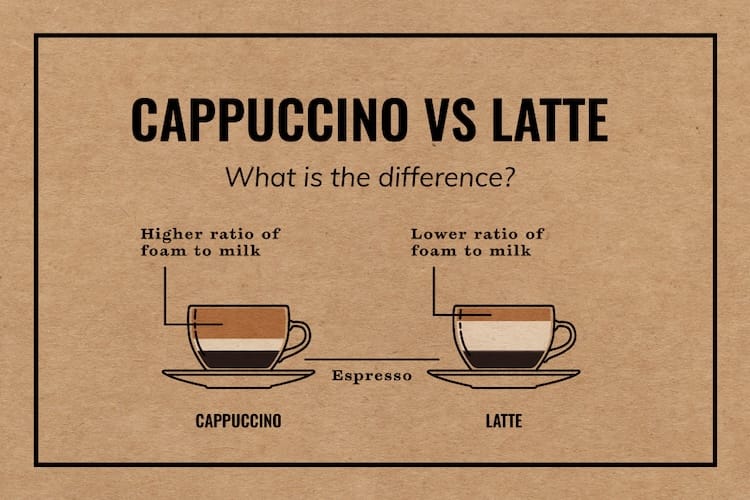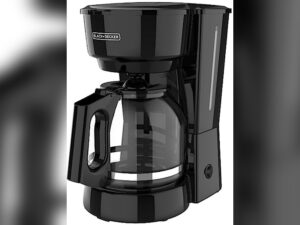Are you a coffee enthusiast who loves the creamy delight of a cappuccino but often wonders just how much coffee it contains? You’re not alone.
Many coffee lovers are curious about what goes into crafting that perfect cup. Understanding the right amount of coffee in a cappuccino can elevate your coffee-making skills to a whole new level. Imagine impressing your friends with a perfectly balanced cappuccino, or simply indulging in your own expertly crafted cup every morning.
This isn’t just about measurements; it’s about transforming your daily coffee ritual into an experience that delights your senses. Stay with us, and discover the secrets that can turn your ordinary cup of joe into a masterpiece.
Cappuccino Basics
Cappuccino blends coffee, milk, and foam into a delightful beverage. Typically, it contains one shot of espresso, which is about 30 milliliters of coffee. This balance creates a rich taste, perfect for coffee lovers seeking a smooth experience.
Cappuccino Basics Cappuccino is a classic coffee drink cherished around the world. It’s not just about the caffeine hit; it’s an experience of taste and aroma. Understanding the basics of a cappuccino can elevate your morning routine or coffee breaks.Components Of A Cappuccino
A cappuccino consists of three main components: espresso, steamed milk, and milk foam. Each element plays a crucial role in delivering that perfect balance of flavors. Typically, a cappuccino is made using equal parts of these components, maintaining harmony in every sip. Consider the espresso as the backbone. It provides the rich, bold coffee flavor. The steamed milk adds a creamy texture, softening the intensity of the espresso. Finally, the milk foam crowns the drink, adding a light, airy finish. Ever watched a barista craft a cappuccino? Notice how they pour the milk in just the right way to create a velvety texture. It’s not just about technique but understanding how each component interacts.Role Of Coffee In Cappuccino
The coffee, or espresso, in a cappuccino is the star of the show. It provides the depth and character of the drink. Without the right espresso, a cappuccino falls flat. Espresso in a cappuccino should be strong and rich. It forms the base that the milk and foam complement. Think about the last time you had a cappuccino – was the coffee flavor prominent and enjoyable? Choosing quality beans is essential. If you’re making cappuccino at home, opt for freshly roasted beans. Grind them right before brewing for maximum flavor. This can make a significant difference. Are you curious about experimenting with different coffee blends? Try using a medium to dark roast for a fuller body and richer taste. Your cup will be more satisfying and authentic. By focusing on the balance of these elements, you can appreciate why the coffee in a cappuccino is so vital. Next time you sip on a cappuccino, pay attention to the coffee’s role and how it shapes your experience.
Credit: coffee.stackexchange.com
Coffee-to-milk Ratio
A cappuccino typically consists of equal parts espresso, steamed milk, and milk foam. This creates a balanced and creamy drink. Adjusting the coffee-to-milk ratio alters the strength and texture, catering to personal taste.
When it comes to enjoying a perfect cup of cappuccino, understanding the coffee-to-milk ratio is essential. This balance not only influences the flavor but also the texture of your drink. Mastering this ratio can transform your morning ritual into a delightful experience, making each sip memorable. Whether you like a strong coffee kick or a creamy texture, adjusting the ratio can cater to your unique taste preferences.Standard Ratios
A traditional cappuccino is typically composed of equal parts espresso, steamed milk, and milk foam. This 1:1:1 ratio is what gives cappuccino its characteristic balance of strength and creaminess. Baristas often use a shot of espresso (about 30ml) and match it with 30ml of steamed milk and an equal amount of milk foam. This standard formula creates a harmonious blend that pleases most palates. But what if you find this ratio too strong or too milky?Adjusting For Personal Taste
Your cappuccino experience doesn’t have to be limited to the standard ratio. If you prefer a stronger coffee flavor, consider increasing the espresso portion while slightly reducing the milk. A 2:1:1 ratio might suit your taste better. On the other hand, if you love a creamier texture, adding more steamed milk can make your cappuccino richer, creating a 1:2:1 ratio. Experimenting with these adjustments can lead to discovering your perfect cup. Have you ever tried making these changes at home and noticed a significant difference? Finding your ideal ratio is a journey of taste exploration—one that’s worth the effort. The next time you order a cappuccino or make one at home, challenge yourself to tweak the ratio and unlock a flavor that’s uniquely yours. Why stick to the norm when a little experimentation can lead to a delightful surprise? Remember, every cappuccino can be a new adventure in taste.Choosing Coffee Beans
Choosing the right coffee beans for your cappuccino is crucial. Different beans can drastically affect the taste. A well-chosen bean can enhance your coffee experience, while a poor choice may ruin it. Let’s explore the types of beans and their impact on flavor.
Types Of Beans
There are two main types of coffee beans: Arabica and Robusta. Arabica beans are popular for their smooth and mild flavor. They are often used in specialty coffees. Robusta beans have a stronger, more bitter taste. They contain more caffeine than Arabica. These beans are cheaper and commonly used in instant coffee. Some blends mix both types for a balanced flavor.
Impact On Flavor
The type of bean significantly influences the cappuccino’s taste. Arabica beans produce a sweet and fruity flavor. They have subtle notes that many enjoy. Robusta beans add a bold and intense taste. They can make the coffee more robust. The choice between these beans depends on your preference. Experiment with different beans to find your ideal flavor.
Credit: www.businessinsider.com
Brewing Techniques
A perfect cappuccino balances espresso, steamed milk, and foam. Typically, use one shot of espresso for every six ounces. This ratio ensures a rich flavor without overpowering the milk.
Brewing a perfect cappuccino is an art form, and understanding the right techniques can make all the difference. Whether you’re a coffee novice or a seasoned barista, knowing how much coffee to use is crucial. The method you choose impacts the flavor and strength of your brew. Let’s dive into some practical brewing techniques that can elevate your cappuccino experience.Espresso Machine Methods
Using an espresso machine is the classic way to brew a cappuccino. Typically, a single shot of espresso requires about 7 grams of coffee. If you prefer a stronger taste, you might use a double shot, which takes about 14 grams. Consider experimenting with the grind size. A finer grind can lead to a richer espresso, while a coarser grind might result in a milder flavor. Remember to tamp the coffee evenly to ensure a consistent extraction.Alternative Brewing Options
If you don’t own an espresso machine, there are still ways to make a delightful cappuccino. A Moka pot can be a great alternative, using a similar amount of coffee as a single or double espresso shot. French press enthusiasts can also create a cappuccino-like brew. Use a coffee-to-water ratio of 1:15 for a balanced flavor, then heat and froth your milk separately. Pour the strong coffee into your cup and top it with the frothy milk. Have you ever tried using an Aeropress for your cappuccino? Adjust the amount of coffee to your taste preference, typically around 14-18 grams. This method offers a unique flavor profile, allowing you to customize your cup to perfection. Trying these techniques can bring a new dimension to your daily coffee ritual. Which method will you experiment with next?Achieving The Perfect Foam
Creating the perfect foam is key to a delicious cappuccino. The foam adds texture and enhances the coffee experience. To get that silky and smooth foam, proper technique is essential. It’s not just about the taste, but also the visual appeal. Let’s explore how to achieve that perfect foam.
Milk Frothing Techniques
Start with fresh, cold milk for the best froth. Whole milk creates a creamy texture. Skim milk can produce more foam, but it’s less rich. Use a steam wand if available. Submerge the tip just below the milk’s surface. This method introduces air, creating foam. Move the pitcher in a circular motion. This helps distribute heat evenly. Avoid overheating, as it affects flavor.
Texture And Consistency
Foam should be smooth and velvety. Large bubbles indicate improper technique. Aim for microfoam with tiny bubbles. This creates a creamy texture. The foam should be thick but not stiff. It should hold its shape when poured. Ideal foam is glossy and shiny. It should blend seamlessly with espresso. Achieving this balance takes practice. Consistency is key for a perfect cappuccino.

Credit: beanbox.com
Common Mistakes
Crafting the perfect cappuccino is an art, but even seasoned coffee lovers can stumble into some common mistakes. These blunders can drastically alter the taste and texture of your drink. If you’ve ever found yourself wondering why your cappuccino doesn’t quite hit the mark, you’re not alone. Let’s explore two frequent missteps that might be sabotaging your coffee experience.
Overpowering Coffee Flavor
Have you ever taken a sip of a cappuccino only to be hit by a wave of bitterness? It’s a common issue caused by using too much coffee. The ideal cappuccino balances espresso, steamed milk, and foam. When the espresso dominates, it can lead to a harsh taste that overshadows the creamy texture of the milk.
Consider adjusting your espresso shot. Use a slightly lighter roast or reduce the amount of coffee grounds. This adjustment can make a world of difference. Have you tried experimenting with different coffee brands or blends? It might be time to explore new options that complement your milk choice.
Incorrect Milk Frothing
The milk frothing process can make or break your cappuccino. Incorrect frothing often results in a disappointing drink. Are you struggling with frothing milk to the right consistency? It’s crucial to achieve a smooth, velvety foam that integrates seamlessly with the espresso.
Start by using cold milk and a clean frothing jug. Practice makes perfect. Try tilting the jug slightly while frothing to create a whirlpool effect. This technique helps develop a dense and creamy foam. Have you considered using a milk thermometer? It ensures you’re not overheating the milk, which can lead to an unpleasant texture.
Remember, the joy of a cappuccino lies in its harmony. Next time you’re crafting one, think about these common mistakes. Are you ready to refine your skills and elevate your coffee game?
Frequently Asked Questions
How Much Coffee Goes In A Cappuccino?
A cappuccino uses one espresso shot, typically 1 ounce of coffee. Combine it with equal parts steamed milk and milk foam. This classic drink balances strong coffee flavor with creamy textures, making it a favorite for coffee enthusiasts. Adjust proportions for personal taste preferences.
Is There A Lot Of Coffee In A Cappuccino?
A cappuccino contains a shot of espresso, which is about 1 ounce of coffee. The rest is steamed milk and foam. The espresso provides the coffee flavor, while the milk and foam create a creamy texture. Cappuccinos are popular for their balanced coffee-to-milk ratio.
Is A Cappuccino 1 Or 2 Shots?
A traditional cappuccino typically contains 1 shot of espresso. Some variations may include 2 shots for a stronger flavor. Always check with your barista for exact preferences.
What Percent Of Cappuccino Is Coffee?
Cappuccino typically consists of around 33% coffee. The drink is made with equal parts espresso, steamed milk, and milk foam. This combination gives cappuccino its rich and creamy flavor, making it a popular choice among coffee enthusiasts.
Conclusion
Cappuccino lovers enjoy its rich, bold taste. Coffee content varies, though. Typically, a cappuccino has one espresso shot. That’s about one ounce. Milk and foam balance the flavors perfectly. Experiment to find your preferred ratio. Some like stronger coffee. Others prefer more milk.
Remember, enjoying your coffee is key. Each sip should delight. Keep exploring different coffee blends. Discover new tastes and aromas. Your perfect cappuccino awaits. Enjoy the journey of coffee discovery.







